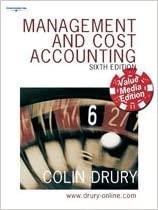If possible can you please show how you got the answers? This is the hw and I just want to make sure I know what I am doing for the exam because I am completely lost. Thank you so much!




Capital Rationing Decision Involving Four Proposals Kopecky Industries Inc. is considering allocating a limited amount of capital investment funds among four proposals. The amount of proposed investment, estimated income from operations, and net cash flow for each proposal are as follows: Project Name Sierra Tango Uniform Victor Investment $900,000 Investment $1,912,500 Investment $1,762,515 Investment $1,013,346 Income from Operations Net Cash Income from Net Cash Flows Net Cash Flows Income from Operations Net Cash Flows Income from Operations Year Flows Operations $96,000 $850,000 $198,000 $380,000 $240,000 240,000 240,000 $450,000 450,000 $107,000 107,000 96,500 850,000 198,000 380,000 850,000 198,000 107,000 380,000 $263,500 263,775 264,050 264,325 264,600 $1,320,250 450,000 450,000 240,000 850,000 97,000 97,500 98,000 $485,000 198,000 198,000 240,000 $1,200,000 850,000 $4,250,000 450,000 $2,250,000 107,000 107,000 $535,000 380,000 380,000 $1,900,000 Total $990,000 Year 1 2 3 4 Present Value of $1 at Compound Interest 6% 10% 12% 15% 20% 0.943 0.9090.8930.870 0.833 0.890 0.826 0.797 0.756 0.694 0.840 0.751 0.712 0.658 0.579 0.792 0.683 0.6360.572 0.482 Total $485,000 $1,200,000 $1,320,250 $4,250,000 $990,000 $2,250,000 $535,000 $1,900,000 Present Value of $1 at Compound Interest Year 6% 10% 12% 15% 20% 1 2 0.943 0.890 0.909 0.826 0.893 0.797 0.870 0.756 0.833 0.694 0.579 0.840 0.751 0.712 0.658 0.792 0.683 0.636 0.572 0.482 0.747 0.621 0.567 0.497 0.402 0.705 0.564 0.507 0.432 0.335 0.513 0.452 0.376 0.279 8 0.665 0.627 0.592 0.467 0.4040.327 0.233 0.424 0.361 0.284 0.194 0.558 0.386 0.322 0.247 0.162 The company's capital rationing policy requires a maximum cash payback period of three years. In addition, a minimum average rate of return of 20% is required on all projects. If the preceding standards are met, the net present value method and present value indexes are used to rank the remaining proposals. 1. Compute the cash payback period for each of the four proposals. Assume that net cash flows are uniform throughout the year. Cash Payback Period Proposal Sierra 3 years 9 months Proposal Tango 2 years 3 months Proposal Uniform 3 years 11 months Proposal Victor 2 years 8 months 2. Giving effect to straight-line depreciation on the investments and assuming no estimated residual value, compute the average rate of return for each of the four proposals. Round to one decimal place. Average Rate of Return Proposal Sierra Proposal Tango Proposal Uniform Proposal Victor 3. Using the results from parts (1) and (2) determine which proposals should be accepted for further analysis and which should be rejected. Accept / Reject Proposal Sierra Reject Proposal Tango Accept for further analysis Proposal Uniform Reject Proposal Victor Accept for further analysis 4. For the proposals accepted for further analysis in part (3), compute the net present value. Use a rate of 12% and the present value of $1 table above. If required, use the minus sign to indicate a subtraction or negative net present value. Select the proposal accepted for further analysis. Proposal Tango Proposal Victor Present value of net cash flow total Amount to be invested Net present value 5. Compute the present value index for each of the proposals in part (4). Round to two decimal places. Select the proposal to compute present value index. Proposal Tango Proposal Victor Present value index (rounded) Accounting numeric field 6. Rank the proposals from most attractive to least attractive, based on the present values of net cash flows computed in part (4). 6. Rank the proposals from most attractive to least attractive, based on the present values of net cash flows computed in part (4). Rank 1st Proposal Tango Rank 2nd Proposal Victor 7. Rank the proposals from most attractive to least attractive, based on the present value indexes computed in part (5). Rank 1st Proposal Tango Rank 2nd Proposal Victor 8. Based on your calculations above, complete the statements below. Looking at the present value computations, Proposal Tango has the larger net present value. Proposal Tango is attractive in terms of amount of present value per dollar invested. Comparing the two proposals, their present value indices have a significant difference (.20 or more) . Lastly, Proposal Tango the larger initial investment. Considering all this information, Kopecky should proceed with Proposal Tango . has











